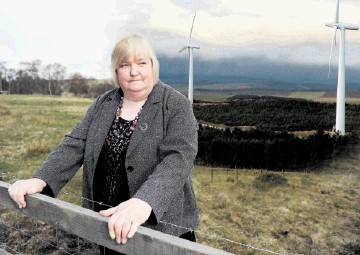
HIGHLAND Council has been accused of trying to plunder cash from people who will have to live in the shadows of huge windfarm developments.
A green energy firm said last night it was unfair that community-benefit funds generated by turbine projects would be spent in areas not affected by the structures.
There were also claims last night that the local authority had drawn up its policy on the distribution of money without consulting local people.
However, the council hit back, insisting it was up to the communities themselves to agree to share their windfalls.
Infinergy – which wants to build a 17-turbine development at Tom nan Clach, near the Dava Moor beauty spot – has offered a benefit of £5,000 per megawatt of capacity.
Under the existing council package, future donations would be split between communities based on their proximity to proposed green energy schemes, the visual impact of any development and the number of nearby homes.
The first £100,000 of annual benefit would be managed by a local fund. From any remaining money, 55% would go to community funds and 30% would go to a region-wide fund.
Another 15% would go to a separate Highland Trust Fund for communities unlikely to have renewable energy schemes of their own but which provide infrastructure such as power lines.
In neighbouring Moray, the council is drawing up a community-benefit policy and members have considered the Highland system as a possible model.
Last night, Infinergy called on the local authority to leave the money “in the hands of the local people”.
Fiona Milligan, the company’s Inverness-based project manager, said: “Local people are often angered by councils effectively confiscating funding which they believe should benefit the immediate vicinity of a windfarm.
“What they are seeing is councils siphoning off sometimes large proportions of funds into vaguely defined, region-wide pots which may end up being spent many miles away, where there is no impact from the windfarm.
“Of course, if local communities are happy for funds to be distributed in line with council guidelines, we will support their right to choose.
“However, our experience is that communities deeply resent councils’ current we-know-best approach.”
Vivian Roden, chairwoman of Strathdearn Community Council, one of the settlements near the proposed Tom nan Clach scheme, said: “The Highland Council community-benefit policy was drawn up without any consultation with the affected communities.
“A one-size-fits-all policy won’t work in an area like Highland as the needs of communities on the west coast, for example, will be different from communities around Inverness.
“In Strathdearn, we are trying to regenerate our community, which suffers from a woeful lack of services. We simply can’t afford to give away our community benefit.
“The money taken by Highland Council is likely to disproportionately benefit some areas of Inverness, purely for geographical reasons, although this is not necessarily where the greatest need is.”
Daviot Community Council chairman Jim Macpherson said: “It is definitely unfair on the people who are directly affected by windfarms.
“The money should go to the folk who will have the windfarm on their doorstep – the benefit should go to them.”
A council spokeswoman said: “The community-benefit policy was agreed at Highland Council and is a voluntary policy that communities can decide whether to engage with and adopt in their local areas.
“The Highland-wide fund is seen as a way of ensuring that the wider Highlands also benefits from renewable energy developments.
“It is for communities to decide whether they want to adopt this approach or not and workshops have been held to explain the policy and its implications.”
